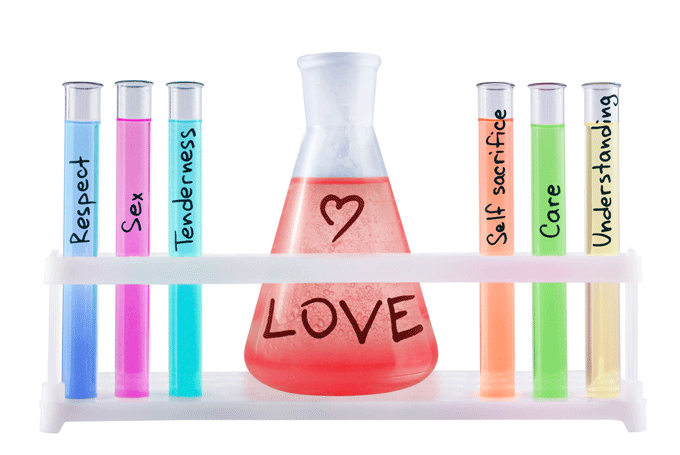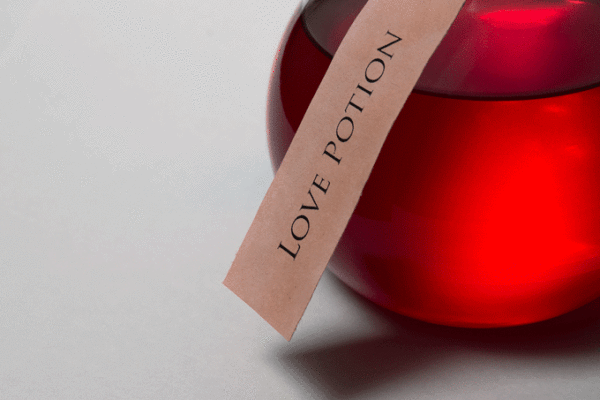When it comes to love, many of us claim we favor a certain “type.” We may also have a mental checklist of desirable traits we seek in a mate, such as a sense of humor, a tall stature, or even a respectable bank account. But according to cultural anthropologist Helen Fisher, a leading expert on the biology of love and attraction, chemistry is what drives us to fall hard for someone.
The powerful feelings shared by two people who are deeply attracted to one another is the stuff romantic poems and songs are made of. But scientists have discovered that love as we humans know it is spurred on by chemicals in our bodies. Was Tina Turner right when she sang, “What’s love got to do with it?” Could that emotion we all yearn for be nothing more than hormone-driven chemistry?
Fisher, who has spent years scanning the brains of people in love, has concluded that “romantic love is deeply embedded in the architecture and chemistry of the human brain.” In her books Why We Love: The Nature and Chemistry of Romantic Love and Why Him? Why Her? Finding Real Love By Understanding Your Personality Type, she explains that attraction comes in three stages: lust, romantic love and long-term attachment. While there’s some overlap, these are basically three separate phenomena, each with its own motivational systems and accompanying chemicals. These systems have basically evolved so that we can successfully mate, bond and co-parent with another person over a period of time.
As it turns out, “chemistry” between two people matters a lot more than we think. While many cultural factors—including socioeconomics, values and intelligence—influence our choice in a partner, biology does too. Each of us possesses varying degrees of chemicals in our bodies (dopamine, serotonin, testosterone and estrogen) that dictate who we will most likely be attracted to. We tend to select partners with chemicals that complement ours; for example, if we are high in estrogen, we may be attracted to a high-testosterone partner. [Here’s a test you can take to determine which of the four chemically driven personality types you are, and whom you’re most compatible with.]
The first stage of love—ahem, lust—is driven by the sex hormones testosterone and estrogen in both males and females. Thanks to these hormones, during this stage you think he looks good, sounds good and smells good, and you are chemically motivated to get physically closer. You don’t know each other very well, but boy, do you want to.
The second stage, romantic love or “falling in love,” is the amazing time when you can think of little else but your beloved (and basically get nothing else done all day). During the onset of passion three main neurotransmitters—adrenaline, dopamine and serotonin—are working overtime in your body, activating your stress response and cortisol levels. Says Fisher, “The delicious pleasure of being with someone you think is special and unique; your feelings of ecstasy, energy and optimism; your intense focus on everything your beloved says and does; your possessiveness and maniacal determination to win this bewitching creature…all swamp the rational mind as you become electrified by craving and obsession. Someone wonderful is camping in your head.”
“The delicious pleasure of being with someone you think is special and unique; your feelings of ecstasy, energy and optimism; your intense focus on everything your beloved says and does; your possessiveness and maniacal determination to win this bewitching creature…all swamp the rational mind as you become electrified by craving and obsession. Someone wonderful is camping in your head.”
In one experiment, Fisher asked newly “love struck” couples to have their brains examined and discovered they have high levels of the neurotransmitter dopamine. This chemical stimulates “desire and reward” by triggering an intense rush of pleasure, producing the same effect on the brain as taking cocaine. Couples in this stage often exhibit the signs of surging dopamine: increased energy, less need for sleep or food, focused attention and “exquisite delight in smallest details of this novel relationship.”
Similarly, a scientist in Italy showed that chemicals released during the “falling in love” stage actually change the way you think. Dr. Donatella Marazziti, a psychiatrist at the University of Pisa, studied 20 couples who had been madly in love for less than six months. Blood samples revealed that serotonin levels of these new lovers were equivalent to the low serotonin levels of Obsessive Compulsive Disorder patients.
Psychologists think this obsession with our lovers is an evolutionary tactic designed to keep couples together as they enter the next stage of love: attachment. During this phase, couples bond long enough for them to have and raise children together—at least for a couple years. Fisher says there are two major hormones involved in this feeling of attachment: oxytocin and vasopressin. Oxytocin is a powerful hormone released by men and women during orgasm. It probably deepens the feelings of attachment and makes couples feel much closer to one another after they have had sex. Vasopressin is another important hormone in the long-term commitment stage and is released after sex.
Of course, sustaining a relationship depends on many non-chemical factors, including personality and lifestyle compatibility and social values. While the “in love” stage typically lasts as long as 18 months before it evolves into attachment love, many couples can sustain the passion much longer. In fact, Fisher has interviewed people who have been married 20 years or more who swear they feel as “in love” with their partner as they did when they first met.
Why do some pairs seem to have that “magic glue” that keeps them together for many years? What’s their secret? Fisher says they work hard to maintain three components in their relationship: novelty (bungee jumping, anyone?), a sense of humor, and regular sex—all of which boost serotonin levels and keep the flames burning.
Successful long-term couples also understand that romance ebbs and flows, that they must nurture common interests in order to rekindle passion, and, above all, that their mutual commitment to staying together for the long haul is key.






















